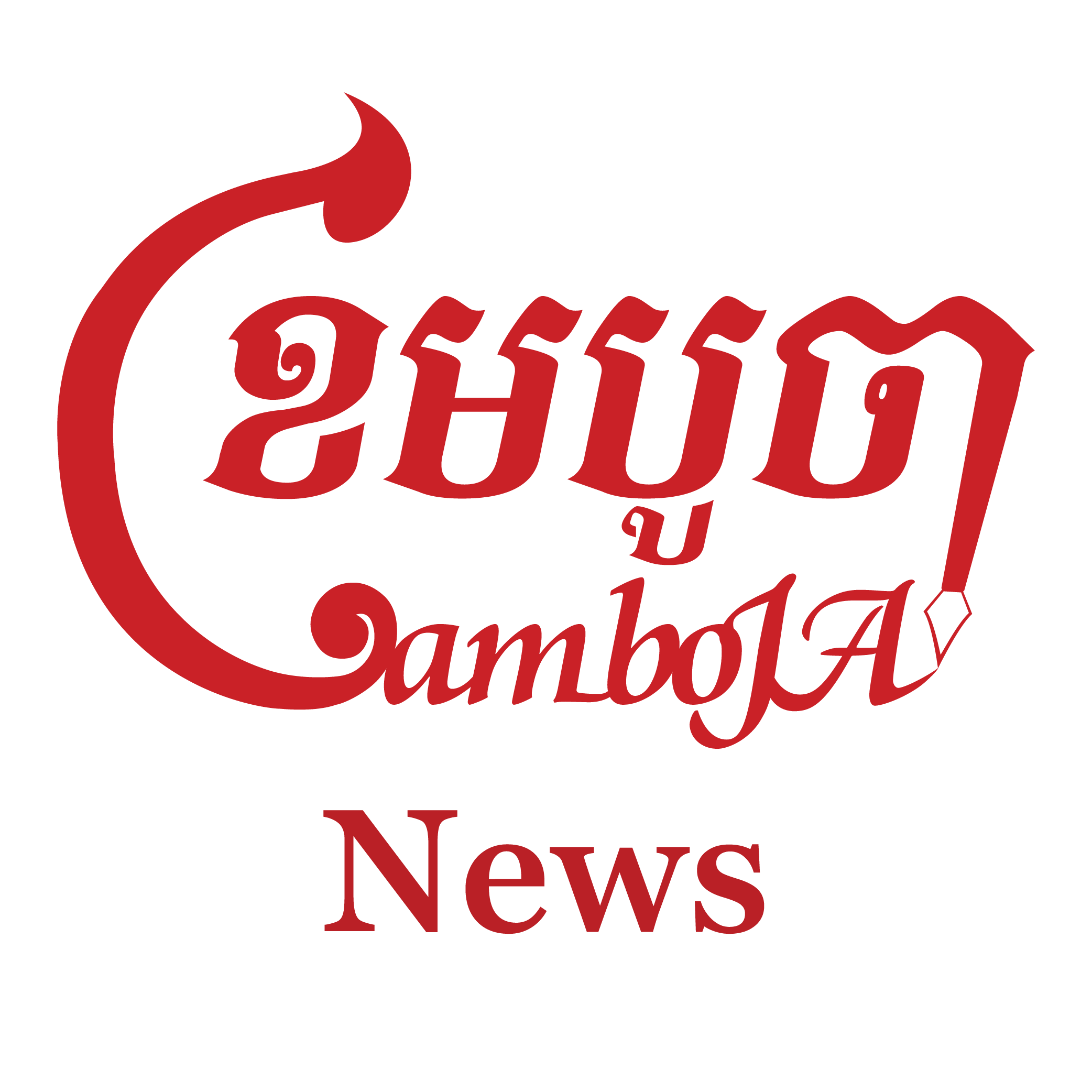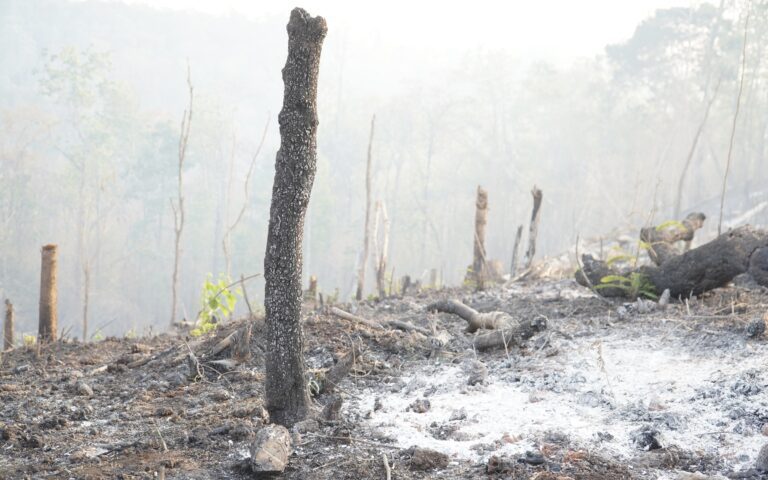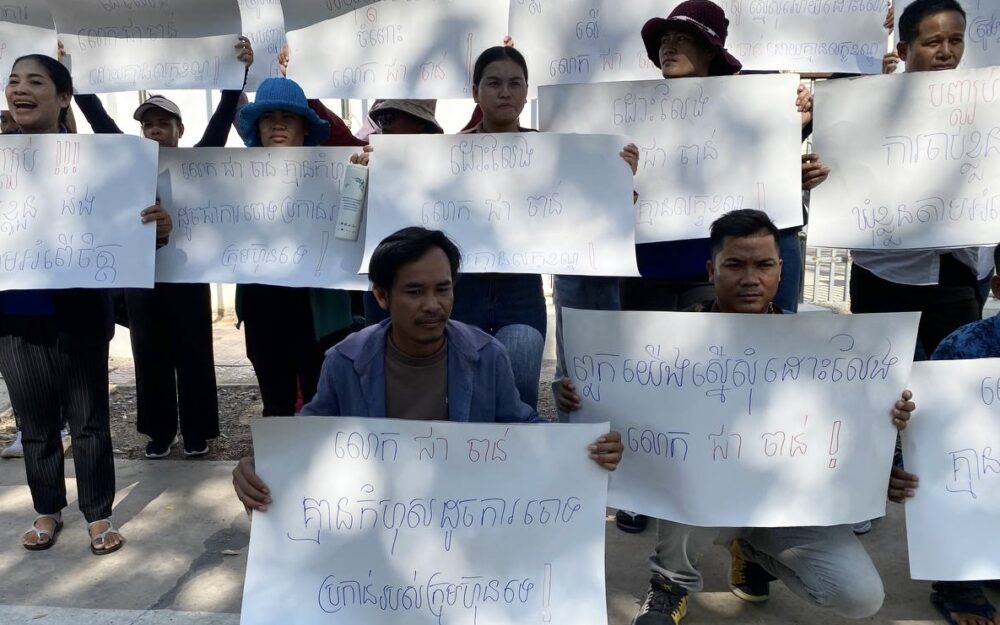Seeing a tiger seemed like something possible for Pyan Chren’s ancestors, but improbable in his day. But the 57-year-old Bunong farmer does recall a time when his neighbors could spot rhinos and peacocks in the Pu Treng community forest, a tiny shred of the Phnom Nam Lyr Wildlife Sanctuary in Mondulkiri province.
Now he only finds about 10 percent of the animal population he remembered when he was younger, despite his best efforts to stop poaching and logging in once-a-month patrols of the community forest.
“I’m a community member so the people don’t respect me, they don’t listen to me, but if I was an authority they would listen,” Chren said.
When the Pu Traeng community forest had steady support from local NGOs wielding international donations, residents said they could keep up with the pressures of protecting their land, but now the community forest, like many others, is being dismantled by timber harvesting, farmland clearance and poaching.

Dak Dam commune’s Pu Traeng community forest and the nearby Pu Les community forest are both within two major protected areas in Mondulkiri – Pu Traeng straddles the Keo Seima Wildlife Sanctuary, while Pu Les is within the Phnom Nam Lyr sanctuary.
An analysis of global deforestation detected by satellites – released annually by the University of Maryland – shows that Phnom Nam Lyr in particular was hit heavily by deforestation around its southern border near Vietnam.
That sanctuary is also home to the economic land concession Mega First Plantation, bordered by ELCs Wuzishan L.S. and Hua Lin International Insurance – both tied to the powerful Pheapimex conglomerate led by notorious tycoon Choeung Sopheap and her husband and Cambodian senator Lao Meng Khin.

Chren, the farmer and forest advocate, said that last year he saw a rise in logs being brought across the Vietnam border. Though that has not yet resumed, he said that around 7 or 8 hectares of their community forest has been lost to farmers in the community, clearing the land for growing cassava – the crop that brings in the most money this year.
Pu Traeng community members have sued local officials in 2022 and protested over officials’ lack of interest in protecting their forest.
“Before there were many NGOs here and [residents] cared about the forest. But the NGOs left and the middlemen came to persuade the people,” said Chren.
Years before, the Pu Traeng and Pu Les community forests used to receive funding from the local Cambodian NGO My Village Organization, which provides some funding for forest patrols and other organizing activities in Indigenous communities.
My Village Organization still operates in Mondulkiri, but its executive director Lonn Pichdara said they can no longer provide as much money to the people who patrol 18 community protected areas and one community forest in Mondulkiri.
Pichdara said they can only support each community to patrol two or three times per month, giving each volunteer 20,000 riels per trip to cover incidentals like a meal and petrol.
The executive director said the decision to reduce funding for community patrols had more to do with the global spending trends than anything.
“It’s a global financial crisis, everyone’s funding is affected,” he said. “For all CSOs [in Cambodia], the funds are going to the countries that are having wars.”
My Village receives funding under USAID’s ongoing “Cambodian Civil Society Strengthening Project”, and though the project frequently distributes its multimillion-dollar project budget among several NGOs, it was not clear from US government data how much the Mondulkiri-based NGO receives in support.
The US Embassy said later that My Village received $100,000 from CSS.
Company troubles
When Chren and his neighbor Tery Plaen took reporters into their community forest, they stopped at a ditch that was recently dug along the border of an economic land concession run by the Malaysian conglomerate Mega First Corporation Berhad.
Plaen, 57, claimed this chasm was dug by workers at Mega First’s command, as the business also wanted to stop loggers crossing the border. He added that they called authorities in to stop loggers sneaking in their concession, which is guarded by military police stationed on the road.
“The [freelance loggers] are also the logging across the company and the company doesn’t want them to cross because it destroys the roads, so they called the national authorities,” Plaen said.

Representatives for Mega First in Cambodia nor Malaysia could be reached for comment. But it was unclear how effective their anti-logging campaign was: reporters saw tire tracks cutting across the red dirt trip, and heard in the distance one chainsaw cutting through birdsong inside the community forest.
The Malaysian conglomerate’s annual reports – which also operates the Don Sahong Hydropower dam on Laos’ border with Stung Treng province – indicate their plantation plans have met problems.
The Cambodian government granted Mega First a 90-year economic land concession for unspecified agricultural activity in 2013, with all 9,477 hectares within Phnom Nam Lyr Wildlife Sanctuary. Some 839.5 hectares were reserved within that for “local people,” according to the concession document.
Two years later, the company had to reduce its lease to 50 years, and by the company’s 2016 annual report, Mega First reported to the Bursa – Malaysia’s stock exchange – that the plantation land had not been handed over to the company at that point.
As the company began planting coconuts and macadamias, the Cambodian government then revoked one-third of Mega First’s land in 2018, as part of a campaign to reduce ELC size nationally after local and international stakeholders criticized the misuse of land, lack of economic benefits and exploitation of residents on ELCs.
The company is not well-regarded by some Pu Traeng community members. Plaen said he was currently in dispute with Mega First as the company was attempting to claim land that he used for farming, saying they met with company officials in February and were trying to work through the issue.

Farms over forests
Srol Nary, a 20-year-old farmer in Pu Traeng village, came back to lunch covered in red dirt from farming through the morning. She and her husband are preparing for another hard year, as last year’s cassava yields were one ton less than the 6 tons they netted in 2022.
“In 2023, there was no rain, and a lot of insects ate our cassava,” she said.
The young couple said they knew that brokers would pass through the village to ask farmers to cut down trees for sale, but they claimed they never partake. Instead, they sometimes collect honey when money is low, Nary said.
“For the rich people, they can leave their farms” when the weather is bad, Nary explained. “There are no opportunities other than farming.”
The Dak Dam commune chief Chas Na said that he always accompanies the Pu Traeng community patrollers, but downplayed the extent of logging: “In the community forest, they have a little land grabbing and logging, where people steal to cut down trees and encroach on plantations.”
Chren, the farmer and forest activist, said he’s found the community to be split over their community forest.
“Some people think like me, others cannot,” he said.
He thinks this mentality has led some to cut down community forest for cassava instead. The land of their forest may have been farmland before the Khmer Rouge, Chren said, but he thinks the forest is worth protecting in the state it is now.
“We get benefits from the forest,” he said. “We have a lot of resources, we get a lot of goods from here: we get mushrooms, wine and wild animals. But now some wild animals are endangered.”
Clarification (April 27): CamboJA made a clarification about the size of grants distributed by CSS.














